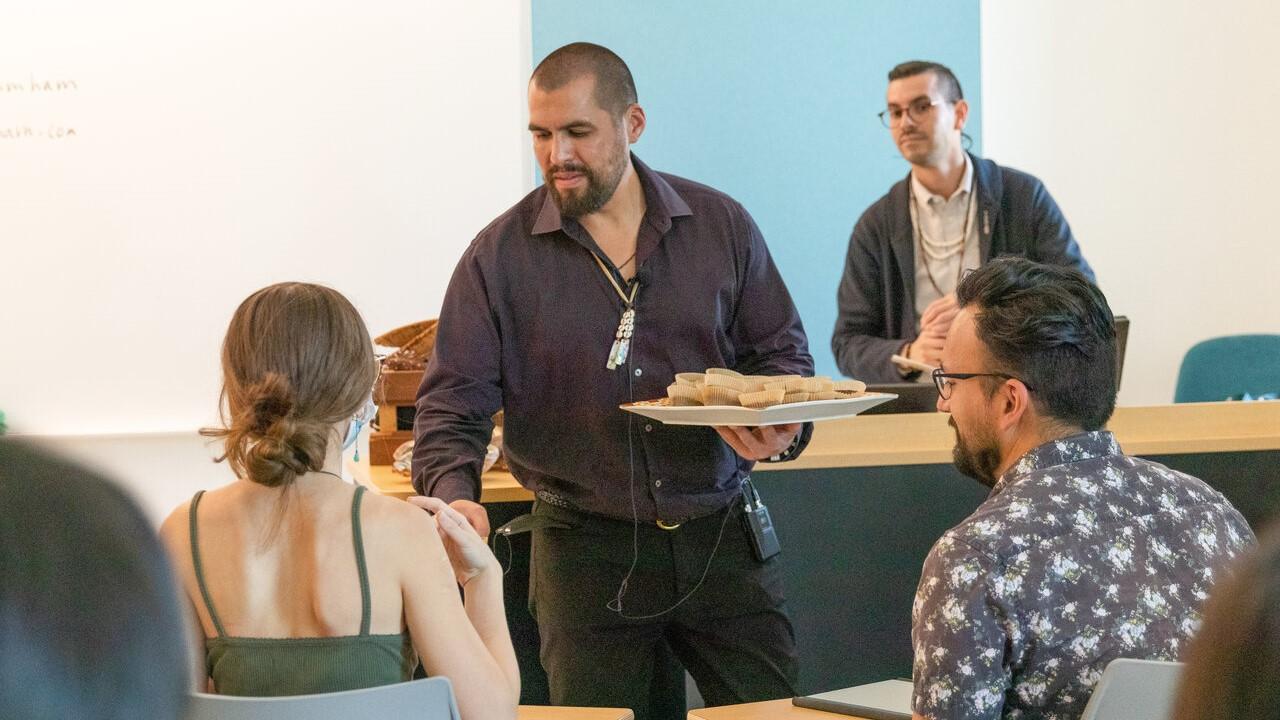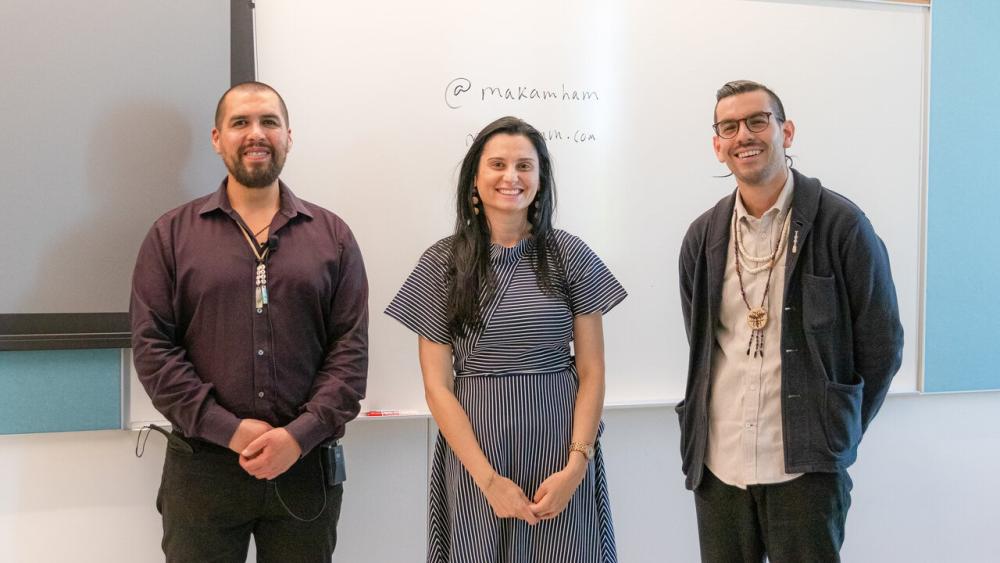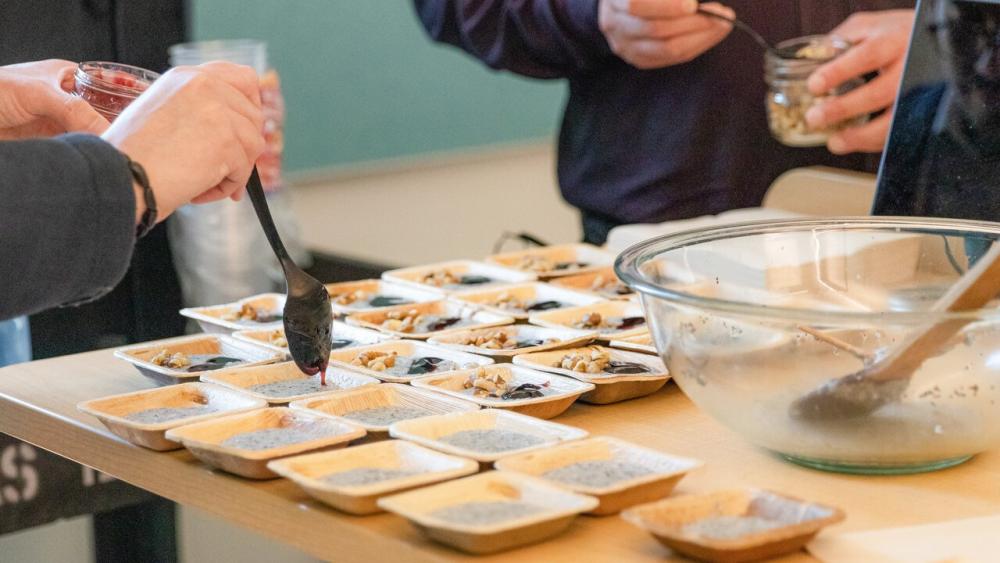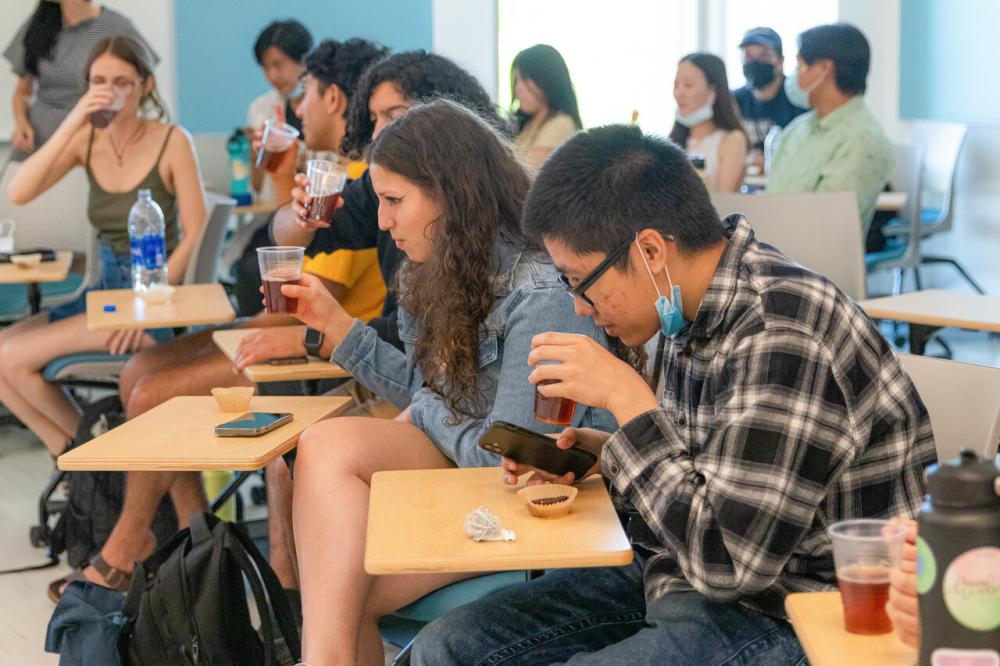
Native American Chefs Teach Chemical Engineering Students About Culture and the Food Industry
Engineering in the food industry requires a combined knowledge of food processes, science, chemical engineering principles and culture. This spring, chemical engineering undergraduate students learned about all four during a guest lecture and Native American cooking demonstration from Vincent Medina and Louis Trevino, founders of Berkeley’s Café Ohlone, the world’s first and only Ohlone restaurant.
After class, Assistant Professor of Teaching Glaucia Helena Carvalho do Prado challenged her students to develop an Ohlone-inspired commercial product. Doing this required them to use their chemical engineering skills to understand the chemical and physical phenomena of the dish and engineer it to be shelf-stable and FDA-compliant while using their new knowledge of Ohlone food, history and culture to honor the traditional recipe and prevent appropriation.
“It’s important for students to be global citizens and understand the principles of different cultures,” she said. “It opens your mind and you start to see things from different perspectives. It also helps you think critically and consider cultural factors when you are designing a proposed solution as an engineer.”
The assignment is part of Prado’s new food engineering course (ECH 198), which debuted at UC Davis in spring 2022. Food engineering combines the principles of food science and chemical engineering to process and preserve food while producing optimal flavor and texture. It’s a popular major in Prado’s native Brazil, but it hasn’t taken off in North America despite the wealth of career opportunities. She hopes the course will encourage chemical engineering students to pursue this career path.
“There are some things like hygiene and sensory analysis that are specific to food industry, so I want chemical engineering students to have this knowledge if they end up working as food process engineers,” she said.

A Story of Victory
When the East Bay Area was colonized, the Ohlone fell under heavy persecution: traditional religion, language, food and practices were banned and the first U.S. governor of California called for genocide. Medina says the tribe got through it together and the elders found ways to quietly keep the culture and Chochenyo language alive in remote parts of Sunol Valley. He says the elders’ work resulted in what he calls “a time of healing” they’ve started to see over the past decade.
“When it’s the right time, the safe time, the culture can trickle out from Ohlone households,” he said. “But it has to happen with respect and healing and it has to happen on our terms.”
A common Ohlone greeting is “brother/sister, have you eaten?” so it’s natural that a restaurant would be the first step for the culture to re-enter the public sphere. Since opening in 2018, Café Ohlone has paved the way for Chochenyo classes, cooking lessons, games and food drop-offs for the community, as well as guest lectures across the region—including at UC Davis. The café’s permanent location in the UC Berkeley Hearst Museum of Anthropology recently opened and is an immersive experience and portal into Ohlone culture.
“We are a living community, and the story of Ohlone culture is not just colonization,” said Medina. “Colonization is not even a long part of a much bigger story. Ours is a story of victory and overcoming; a story of triumphs, not defeat.”
A Story of Learning
For the demonstration, Trevino made pattih, a chia seed porridge. He combined the chia with nut milk using a dogwood whisk and sweetened the dish with candy cap mushrooms, which grow in the East Bay and have a strong caramel/vanilla/maple aroma. He then topped it with black walnuts and elderberry jam, two traditionally gathered ingredients.
He explained that pattih doesn’t work with dairy milk and with most of the quarter under their belt, the students knew everything they needed to figure out why. In a recent lab, the class made ricotta from scratch to learn how dairy is processed, pasteurized and stored and developed a phase diagram for the cheese under different temperatures and pH’s.
“If you change the process conditions, you need to know if you will have a solid, gas or liquid because it’s going to behave differently,” said Prado. “You can then manipulate phase transitions by changing process conditions to get the perfect texture.”

Other food industry basics Prado taught included water activity and the Maillard reaction—commonly known as browning. The students also used heat transfer equations to calculate when an enzyme in a vegetable is deactivated during blanching and compared the viscosity of different starch-based thickeners for soups, sauces and jams. The final lab involved sensory analysis, where panel of students did a blind taste test to try and tell Sprite and 7-Up apart.
“If [a company] changes an ingredient supplier, you need to know if customers will notice, so you’re going to be working with the sensory analysis team a lot,” she said.
There were also optional at-home assignments such as checking oven temperature and making recipes to re-enforce what they learned in class. In all the assignments, Prado made a point to connect them with chemical engineering concepts like thermodynamics, kinetics and transport the students had been learning all year.
“Her teaching style’s amazing,” said third-year chemical engineering major Issamar Garcia. “She manages to give you a large-scale overview of thermodynamics, heat and mass transfer and brings in concepts from other classes to show how it all ties in.”
A Story of Opportunity
Prado also ties in culture, which is increasingly important in a global world and in the food industry, where cultural appropriation can be a problem. She hopes that as they ate the pattih and rawwni—Trevino’s signature Ohlone brownies made with black walnuts, chia seed flour and hand-gathered sea salt—and drank rose hip tea (mamakwa tawwa sii), her students gained an appreciation for everything food engineers do and be prepared to work in the industry.

So far, it seems to be successful. Garcia says she now checks the ingredients list on her food at home to see if there are any additives or sugars she recognizes, and several students say they’re considering food engineering as a career because of the class.
“[Prado’s] passion for food engineering is driving me to learn more,” said third-year biochemical engineering major Vincent Saturno. “Now that I know that there is such a thing as food engineering, I know I want to do that with my major.”
The plan is to continue to offer the course, develop more labs and eventually look into making it a permanent part of the curriculum. Prado thinks it has the potential to be a flagship course for the department and help diversify the field, as food industry is one of the most popular career paths for women in chemical engineering.
“If we can design classes that are aligned with the career interests of female chemical engineering students, then maybe we can attract more,” she said.
